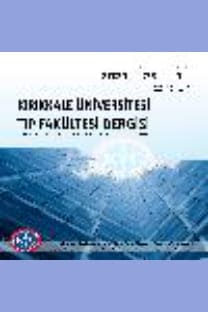Yanık Sonrası Pulmoner Tromboemboli Gelişen Bir Çocuk Olgu
yanık, pulmoner tromboemboli, çocuk, heparin
PULMONARY THROMBOEMBOLISM IN A CHILD AFTER BURN INJURY
burn, pulmoner thromboembolism, pediatric, heparin,
___
- 1. Babyn PS, Gahunia HK, Massicotte P. Pulmonary thromboembolism in children. Pediatr Radiol 2005;35(3):258-74.
- 2. Rue LW, Cioffi WG, Rush R, McManus WF, Pruitt BA Jr. Thromboembolic complications in thermally injured patients. World J Surg 1992;16(6):1151-4.
- 3. Wahl WL, Brandt MM. Potential risk factors for deep venous thrombosis in burn patients. J Burn Care Rehabil 2001;22(2):128–31.
- 4. Reith FC, Van den Brande R, Synnot A, Gruen R, Maas AI. The reliability of the Glasgow Coma Scale: a systematic review. Intensive Care Med 2006;42(1):3-15.
- 5. Barret JP, Dziewulski PG. Complications of the hypercoagulable status in burn injury. Burns 2006;32(8):1005-8.
- 6. Mullins F, Mian MA, Jenkins D, Brandigi C, Shaver JR, Friedman B et al. Thromboembolic complications in burn patients and associated risk factors. J Burn Care Res. 2013;34(3):355-60.
- 7. Heymans O, Lemaire V, Nélissen X, Verhelle N, Jacquemin D, Jacob E. Deep vein thrombosis in a burn patient. Rev Med Liege. 2002;57(9):587-90.
- 8. Gülcü A, Akkoçlu A, Yılmaz E, Öztürk B, Osma E, Şengün B. The comparison of the clinical probability with computed tomography pulmonary angiography findings for the pulmonary embolism (PE) diagnosis. Tuberk Toraks. 2007;55(2):174–81.
- 9. Heit JA, O'Fallon WM, Petterson TM, Lohse CM, Silverstein MD, Mohr DN et al. Relative impact of risk factors for deep vein thrombosis and pulmonary embolism a population-based study. Arch Intern Med. 2002;162(11):1245-8.
- 10. Torbicki A, Perrier A, Konstantinides S, Agnelli G, Galiè N, Pruszczyk P et al. Guidelines on the diagnosis and management of acute pulmonary embolism the task force for the diagnosis and management of acute pulmonary embolism of the European Society of Cardiology (ESC). Eur Heart J. 2008;29(18):2276–315.
- 11. Ghanima W, Abdelnoor M, Holmen LO, Nielssen BE, Sandset PM. The association between the proximal extension of the clot and the severity of pulmonary embolism (PE): a proposal for a new radiological score for PE. J Intern Med. 2007;261(1):74-81.
- 12. Ginsberg JS, Wells PS, Kearon C, Anderson D, Crowther M, Weitz JI et al. Sensitivity and specificity of a rapid whole blood assay for D-dimer in the diagnosis of pulmonary embolism. Ann Intern Med. 1998;129(12):1006–11.
- 13. Arseven O, Sevinç C, Alataş F, Ekim N, Erkan L, Findik S, et al. The report for the diagnosis and therapeutical consensus of pulmonary thromboembolism. Tur Toraks Der. 2009;10(11):7-47.
- 14. Tapson VF, Witty LA. Massive pulmonary embolism. Diagnostic and therapeutic strategies. Clin Chest Med. 1995;16(2):329-40.
- 15. Desai MH, Linares HA, Herndon DN. Pulmonary embolism in burned children. Burns. 1989;15(6):376-380.
- 16. Fecher AM, O'Mara MS, Goldfarb IW, Slater H, Garvin R, Birdas TJ et al. Analysis of deep vein thrombosis in burn patients. Burns. 200430(6):591-93.
- 17. Geerts WH, Bergqvist D, Pineo GF, Heit JA, Samama CM, Lassen MR et al. American College of Chest Physicians. Prevention of venous thromboembolism: American College of Chest Physicians evidence-based clinical practice guidelines (8th Edition). Chest. 2008;133(6):381S–453S.
- ISSN: 2148-9645
- Yayın Aralığı: Yılda 3 Sayı
- Başlangıç: 1999
- Yayıncı: KIRIKKALE ÜNİVERSİTESİ KÜTÜPHANE VE DOKÜMANTASYON BAŞKANLIĞI
Gebelikte Hipertansiyon: Bibliyometrik Bir Çalışma
Ercan KAHRAMAN, Engin YILDIRIM
SAFRA KESESİ POLİPLERİNE YAKLAŞIM: TEK MERKEZ DENEYİMİ
Uğur KILINÇ, Ahmet ERDOĞAN, Ahmet TÜRKAN
Ramazan BÜLBÜL, Mehmet Murat IŞIKALAN, Ali ACAR
Serdar ŞAHİN, Mehmet KUBAT, Turgut ÇAVUŞOĞLU, Hüseyin ÜSTÜN
HEMŞİRELERİN YAŞAM BULGULARINA İLİŞKİN TUTUM VE UYGULAMALARININ BELİRLENMESİ
EMEL GÜLNAR, Esra DOĞAN YILMAZ, Hüsna ÖZVEREN
Engin YILDIRIM, Mehmet Kürşat DERİCİ, Can TÜRKLER
Yanık Sonrası Pulmoner Tromboemboli Gelişen Bir Çocuk Olgu
Tahir DALKIRAN, Olcay GÜNGÖR, Yaşar KANDUR, Besra DAĞOĞLU, Can ACIPAYAM, Ayşegül ALPCAN, SERKAN TURSUN
PERKÜTAN NEFROLİTOTOMİDE BAŞARIYI ETKİLEYEN FAKTÖRLER
Mustafa KARABIÇAK, Erkan ARSLAN, Batuhan ERGANİ, Hakan TÜRK
Erman CEYMAN, Fatih İNCİ, Cahit KOÇAK, İbrahim Alper YAVUZ, Hakan TIR, Utku GÜRHAN, GÜLCAN HARPUT
COVID-19’UN NADİR PREZENTASYONU: KONJONKTİVİT VE OKÜLER TUTULUM İLE GİDEN VAKA SERİSİ
Enis ADEMOĞLU, Mehmet Muzaffer İSLAM, Gökhan AKSEL, Serkan Emre EROĞLU
